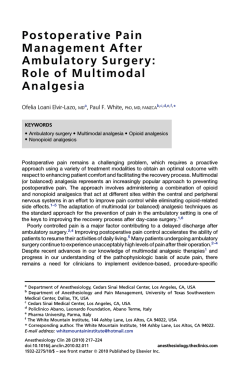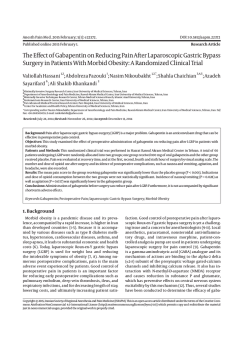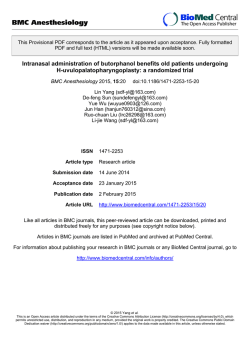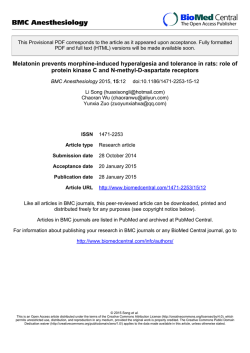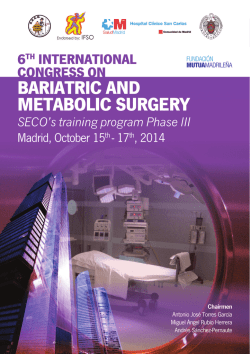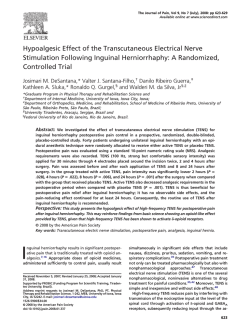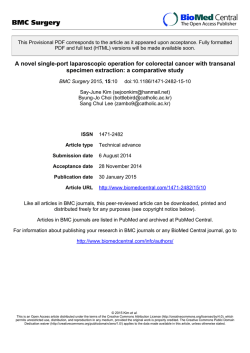
Download [ PDF ] - journal of evolution of medical and dental sciences
DOI: 10.14260/jemds/2015/204 ORIGINAL ARTICLE PREEMPTIVE PREGABLIN: EFFICACY ON POSTOPERATIVE PAIN RELIEF AND OPIOID SPARING IN LOWER ABDOMINAL SURGERIES Mohamed Ommid1, Arsi Taj2, Javid Iqbal3, Shafa Abeeda H. A4, Saba Ahad5, Sami Ullah Mujoo6, Mohsin Wazir7, Naseer Ahmead Dar8 HOW TO CITE THIS ARTICLE: Mohamed Ommid, Arsi Taj, Javid Iqbal, Shafa Abeeda H. A, Saba Ahad, Sami Ullah Mujoo, Mohsin Wazir, Naseer Ahmead Dar. “Preemptive Pregablin: Efficacy on Postoperative Pain Relief and Opioid Sparing In Lower Abdominal Surgeries”. Journal of Evolution of Medical and Dental Sciences 2015; Vol. 4, Issue 09, January 29; Page: 1449-1456, DOI: 10.14260/jemds/2015/204 ABSTRACT: OBJECTIVES: We aimed to evaluate the preemptive analgesic properties of pregabalin, an anticonvulsant drug used in clinical practice for the treatment of neuropathic pain. METHODS: This study was performed on 40 patients from ASA I-II risk group aged 18-60 years which underwent lower abdominal surgeries. Group I received 300 mg pregabalin and Group II was given a placebo in oral capsule form.Visual analog scale (VAS) scores, morphine consumption and side effects of all patients were recorded at 1, 4, 8, 12 and 24 hours postoperatively. When Aldrette recovery score reached 9, morphine 0.75mcg/kg was given as rescue analgesia. RESULTS: There was no difference observed in the first analgesic requirement time values between the two groups (p>0.05). A statistically significant decrease was observed in the VAS scores of the pregabalin group at 1, 4, 12 and 24 hours after surgery (p<0.005). Total morphine consumption in the pregabalin group was statistically significantly lower than in the control group at 8, 12 and 24 hours after surgery (p<0.005). No significant difference was observed between the two groups regarding side effects during the first postoperative 24 hours (p>0.05). CONCLUSION: Our study demonstrated that a 300 mg pregabalin administered preoperatively is an efficient and safe agent for preemptive analgesia. Premedication with pregabalin reduces postoperative pain scores and total analgesic consumption without increasing sedation or other side effects in the postoperative period. KEYWORDS: premptive, pregabalin analgesia; morphine. INTRODUCTION: In postoperative period proper analgesia management increases patient’s postoperative well-being and reduces development of complications that can result in an extended hospital stay and increased costs.(1) Acute pain after surgery has been as predictor of persistent pain after surgery and about 550% of patients experience persistent post-operative pain in different varieties of surgical operations.(2) Recent advances in the pathophysiology of pain have provided the possibility of prevention or reduction of excessive excitability of the central nervous system (CNS) associated with post-operative intensified pain.(3) Multimodal pain management modalities include the use of opioid analgesics, non-opioid analgesics and drugs from local anesthetics group applied using regional techniques(3) Advances in the molecular mechanisms has led to the development of multidimensional analgesia and using new pharmaceutical products on post-operative pain control.(4) It has been shown that nociceptive stimuli via afferent C fibers cause hyperexcitation in dorsal neurons of the spinal cord. The aim of the preemptive analgesia is to block postoperative pain by inhibiting this sensitization. Many different drugs such as paracetamol, lornoxicam, ketamine or gabapentin as well as regional blocks have been used for the purpose of preemptive analgesia.(5-8) J of Evolution of Med and Dent Sci/ eISSN- 2278-4802, pISSN- 2278-4748/ Vol. 4/ Issue 09/Jan 29, 2015 Page 1449 DOI: 10.14260/jemds/2015/204 ORIGINAL ARTICLE Pregabalin is a lipophilic gamma-amino-butyric acid (GABA) analog with anticonvulsant, anxiolytic and sleep-modulating properties. pregabalin was shown to be effective in several models of neuropathic pain(9-11) incisional injury(12) and inflammatory injury(13,14) Gabapentin has been found to reduce pain intensity, opioid consumption, and opioid-related adverse effects after surgery(15,16) However, compared to gabapentin, pregabalin is more rapidly absorbed (1 h vs. 3–4 h) and has higher bioavailability (90% vs. 33– 66%).(17) The mechanism of action of pregabalin is similar to gabapentin. It binds to the α2-δ subunit of presynaptic, voltage-dependent calcium channels that are widely distributed throughout the central and peripheral nervous system.(18-21) Pregabalin binds to the α2-δ subunit six times more potently than gabapentin.(22) In this study we aimed to evaluate the preemptive analgesic activity of pregabalin in combination with paracetamol patients undergoing elective abdominal surgeries, considering abdominal surgery is a painful procedure with potential to generate central sensitization and peripheral hypersensitivity. MATERIALS AND METHODS: After obtaining clearance from institutional ethics committee, forty patients were enrolled in this prospective, randomized, double-blind study from May 2012 to December 2013. Written informed consent from the forty patients aged 18-60 years, from ASA I-II group scheduled for lower abdominal surgeries under general anesthesia were included in the study. Patients with known renal, hepatic, pulmonary or cardiovascular system’s problems, drug or alcohol addiction, history of allergy and obese patients were excluded from the study. Non-premedicated patients were kept fasting for 8 hours prior to the surgery and randomized into two groups using the sealed envelope method. Group I (n=20) received 300 mg of oral pregabalin and Group II (n=20) oral placebo capsules, both given 60 minutes prior to the surgery. Minimal mandatory monitoring was attached and patients admitted to the operating hall were monitored for electrocardiography (ECG), systolic blood pressure (SBP), diastolic blood pressure (DBP), mean blood pressure (MBP), heart rate (HR) and peripheral oxygen saturation (SpO2). These parameters were recorded pre-induction, postinduction, 1, 5, 30 and 60 minutes after intubation and after extubation. Anesthesia for both groups was induced with propofol 2-3 mg/kg and atracurium 0.5 mg/kg. isoflurane 1-2%, and a mixture of 50% N2O in O2 were used for the maintenance of anesthesia for intubated patients. Analgesia was provided by 0.1mg/kg of morphine. At the conclusion of the surgery, a neuromuscular block was antagonized with neostigmine 0.04 mg/kg and 0.2 mg/kg atropine. The duration of anesthesia and duration of surgeries were recorded. All patients were transferred to the postoperative care unit. All patients’ SBP, DBP, MBP, HR, SpO2, Visual analog scale (VAS) scores, Ramsay Sedation Scale values (RSS), total morphine consumption and side effects (nausea, vomiting, increase in oral secretion, nightmares, double vision, hallucination, agitation) were recorded at 1, 4, 8, 12 and 24 hours after the point when the Alderette Recovery Score reached 9, morphine 75 mcg/kg dose was given. Patients with complaints of severe nausea and vomiting were treated with 0.1 mg /kg ondansetron. The results obtained in the study were evaluated using the SPSS (Statistic Package for Social Sciences) program, version 9.0. While the p-value < 0.05 was considered statistically significant, the p-value < 0.005 was accepted as highly significant. J of Evolution of Med and Dent Sci/ eISSN- 2278-4802, pISSN- 2278-4748/ Vol. 4/ Issue 09/Jan 29, 2015 Page 1450 DOI: 10.14260/jemds/2015/204 ORIGINAL ARTICLE RESULTS: The two groups were compared statistically and No statistically significant difference was found between the groups regarding patients demographic data, duration of the surgeries and the anesthesia (p>0.05, table 1). Patients were monitored in the recovery room for the first hour after the surgery and then shifted to ward. A comparison of patients’ first analgesic requirement times showed that patients from the pregabalin group had a delayed analgesic requirement; however, this difference was not statistically significant (p=0.2, respectively, 32.10 ± 6.52 min, 29.4.0 ± 8.68 min). There was no statistical difference between the two groups regarding hemodynamic parameters recorded intraoperative and postoperative in given time intervals (p>0.05). Postoperative VAS values recorded after 1 hour were comparable and statistically insignificant in both groups of patients (p>0.05). However, a decrease of the VAS values recorded after 4, 8, 12 and 24 hours in the pregabalin group compared with the placebo group was found to be highly significant statistically (p<0.005,table 2). Postoperative morphine administered and total morphine consumption at 8, 12, and 24 hours was significantly lower in the pregabalin group compared with the placebo group (p<0.005, table 2). All patients were asked about side effects 24 hours after the surgery. Two patients from Group I (10%) and 4 patients from group II (20%) reported nausea. Additionally, pruritus was seen in one patient from Group I. No statistically significant difference was observed between the groups in the postoperative period regarding the Ramsay Sedation Scale score (p>0.05). Group 1 Group 2 P value Age 46.23±12.16 45.83±11.28 0.70 Weight 64.62 ± 7.8 62.69±7.4 0.32 Anesthesia time (min) 114.74 ± 34.64 123.61± 42.19 0.41 Surgical time (min) 106.44±31.26 117.36 ± 39.24 0.30 Table 1: Demographic data *: p.>0.05 not statistically significant. Group 1 Group 2 P value 1 hour 1.70 ± 0.81 1.88 ± 0.9 0.79 4 hour 6.7 ± 2.3 8.7 ± 1.2 0.08 8 hour 9.8 ± 3.1 16.3 ± 1.3 0.0001* 12 hour 12.9 ± 4.2 23 ± 2.1 0.0001* 24 hour 19.4 ± 6.1 30.1 ± 4.9 0.0001* Table 2: Comparision of postoperative morphine consumption between the two groups *: p<0.005 Statistically Significant. J of Evolution of Med and Dent Sci/ eISSN- 2278-4802, pISSN- 2278-4748/ Vol. 4/ Issue 09/Jan 29, 2015 Page 1451 DOI: 10.14260/jemds/2015/204 ORIGINAL ARTICLE Graph 1: Representation of postoperative morphine consumption DISCUSSION: The multimodal analgesic technique is commonly used for acute postoperative pain and it is based on judicious use of opioids, nonsteroidal anti-inflammatory drugs (NSAIDs), paracetamol, small dose ketamine, and regional blocks with local anesthetics The quest for an ideal drug is ongoing and a drug which has opioid-sparing analgesic effect, an anxiolytic property without the adverse effects of traditional analgesics mentioned, can be an attractive adjuvant for acute perioperative analgesia.(16) The present study showed that premedication with pregabalin reduces postoperative pain scores and analgesic consumption after abdominal hysterectomy without increasing sedation or other side effects. According to recent evidence, along with the use of gabapentin and pregabalin as effective analgesics in patients with neuropathic pain or chronic pain syndrome, preemptive administration of these drugs provides effective postoperative analgesia.(23,24) By reducing the hyperexcitability of dorsal horn neurons induced by tissue damage, pregabalin may have a role in postoperative pain management.(25,26,27) The anxiolytic effect of pregabalin and its ability to prevent opioid tolerance may be beneficial.(28,29) In this study, we aimed to evaluate the preemptive analgesic activity of pregabalin in patients undergoing elective abdominal hysterectomy, considering abdominal surgery to be a painful procedure with potential to generate central sensitization and peripheral hypersensitivity. A preoperative 300 mg of pregabalin and a loading dose of morphine administered 15 minutes before the end of the surgery were given to the patients. When morphine consumption between the two groups was it was seen that morphine consumption at 4, 8, 12 and 24 hours was lower in the pregabalin group compared with the placebo group. Comparison of the results of the two groups showed a significant fact that VAS values and the morphine consumption decreased simultaneously. Although the first analgesic requirement times of the patients given pregabalin were longer then in the placebo group, this difference was not found to be significant statistically. The first analgesic requirement time values obtained in this study were found to be similar to those in two different studies on preoperative pregabalin effects by Jokela et al.(30,31) The analgesic requirements in our study raised statistically significantly for all subsequently observed. J of Evolution of Med and Dent Sci/ eISSN- 2278-4802, pISSN- 2278-4748/ Vol. 4/ Issue 09/Jan 29, 2015 Page 1452 DOI: 10.14260/jemds/2015/204 ORIGINAL ARTICLE In a study by hill 2001(32) statistically significant differences were observed in pain relief, pain intensity difference, and pain relief intensity difference between the 300-mg pregabalin group and placebo. The results were comparable to our study. In another study Ittichaikulthol, 2009(33) patients undergoing Abdominal hysterectomy comparing 2 groups 300 mg pregablin vs. lorazepam 0.5 mg 1 h before surgery. Compared to the lorazepam group, patients in the pregabalin group had lower pain scores on the verbal numerical rating scale (P<0.01) and lower morphine Consumption in the first 24 h. The incidence of somnolence, dizziness, nausea, and vomiting were equal among both the groups the results in accordance to our study. The Cochrane database reviewed the double-blind RCT reporting on the analgesic effect of pregabalin, with subjective pain assessment by the patient as either the primary or a secondary outcome. A total of 19 studies involving 7003 patients were reviewed. It was found that pregabalin doses ≥300 mg/day were effective analgesics in post herpetic neuralgia, diabetic neuropathy, central neuropathic pain, and fibromyalgia whereas doses ≤150 mg/day were generally ineffective. Various studies on laparoscopic procedures have showed varied results with some not showing any significant reduction in postoperative opioid use(34,35) whereas others have(36,37) reported significant differences in postoperative VAS values and opioid consumption. The reason these results are different than results we obtained could be the fact that while they used the laparoscopic method with different postoperative pain mechanisms, patients in our study underwent laparotomy. Our study clearly shows an improvement in VAS scores in the postoperative period for abdominal surgeries. The reported side effects of pregablin are somnolence, dizziness, confusion, headache, ataxia and weight gain.(38) Whereas most of these side effects were reported for chronic use, the most common side effects for postoperative patients were dizziness, somnolence and sedation. In our study 2 patients reported with nausea and 1 had pruritis. REFERENCES: 1. Beyaz SG, Bayar F, Erdem AF. Acute postoperative pain. J Anesthe Clinic Res 2011; S7: 002. 2. Kehlet H, Jensen TS, Woolf CJ. Persistent postsurgical pain: Risk factors and prevention. Lancet. 2006; 367: 1618–25. [PubMed] 3. Buvanendran A, Kroin JS, Kari M, Tuman KJ. Can a single dose of 300 mg of pregabalin reach acute antihyperalgesic levels in the central nervous system? Reg Anesth Pain Med. 2010; 35: 535–8. 4. Vadivelu N, Mitra S, Narayan D. Recent advances in postoperative pain management. Yale J Biol Med. 2010; 83: 11–25. 5. Beyaz SG. (Preemptive analgesic effect of ketamine in children with lower abdominal surgery). Balkan Med J 2011; 28: 179-183. 6. Moiniche S, Kehlet H, Dahl JB. A qualitative and quantitative systematic review of preemptive analgesia for postoperative pain relief: the role of timing of analgesia. Anesthesiology 2002; 96 (3): 725-41. J of Evolution of Med and Dent Sci/ eISSN- 2278-4802, pISSN- 2278-4748/ Vol. 4/ Issue 09/Jan 29, 2015 Page 1453 DOI: 10.14260/jemds/2015/204 ORIGINAL ARTICLE 7. Garcia RM, Cassinelli EH, Messerschmitt PJ, Furey CG, Bohlman HH. A multimodal approach for postoperative pain management after lumbar decompression surgery: a prospective, randomized study. J Spinal Disord Tech. 2013; 26 (6): 291-7. 8. Beyaz SG. Comparison of preemptive intravenous paracetamol and caudal clock in terms of analgesic and hemodynamic parameters in children. J Clin Exp Invest 2012; 3 (2): 202-208. 9. Partridge B, Chaplan S, Sakamoto E, Yaksh T. Characterization of the effects of gabapentin and 3-isobutyl-γ-aminobutyric acid on substance P-induced thermal hyperalgesia. Anesthesiology 1998; 88: 196-205. 10. Jun J, Yaksh T. The effect of intrathecal gabapentin and 3-isobutyl- γ-aminobutyric acid on the hyperalgesia observed after thermal injury in the rat. Anesth Analg 1998; 86: 348-54. 11. Nozaki-Taguchi N, Chaplan SR, Higuera ES, Ajakwe RC, Yaksh TL. Vincristine-induced allodynia in the rat. Pain 2001; 93: 69-76. 12. Field MJ, Holloman EF, McCleary S, Hughes J, Singh L. Evaluation of gabapentin and S-(+)-3isobutylgaba in a rat model of postoperative pain. J Pharmacol Exp Ther 1997; 282: 1242-6. 13. Field M, Oles R, Lewis A, McCleary S, Hughes J, Singh L. Gabapentin (neurontin) and S-(+)-3isobutylgaba represent a novel class of selective antihyperalgesic agents. Br J Pharmacol 1997; 121: 1513-22. 14. Houghton AK, Lu Y, Westlund KN. S-(+)-3-Isobutylgaba and its stereoisomer reduces the amount of inflammation and hyperalgesia in an acute arthritis model in the rat. J Pharmacol Exp Ther 1998; 285: 533-8. 15. Ho KY, Gan TJ, Habib AS. Gabapentin and postoperativepain—a systematic review of randomized controlled trials. Pain 2006; 126: 91-101. 16. Tiippana EM, Hamunen K, Kontinen VK, Kalso E. Do Surgical Patients Benefit from Perioperative Gabapentin/Pregabalin? A Systematic Review of Efficacy and Safety. Anesth Analg 2007; 104: 1545-56. 17. Ben-Menachem E. Pregabalin pharmacology and its relevance to clinical practice. Epilepsia 2004; 45: 13-8. 18. Arikkath J, Campbell KP. Auxiliary subunits: Essential components of the voltage-gated calcium channel complex. Curr Opin Neurobiol 2003; 13: 298-307. 19. Bian F, Li Z, Offord J, Davis M, McCormick J, Taylor C. Calcium channel α(2)-δ type 1 subunit is the major binding protein for pregabalin in neocortex, hippocampus, amygdala, and spinal cord: An ex vivo autoradiographic study in α(2)-δ type 1 genetically modified mice. Brain Res 2006; 1: 1-6. 20. Belliotti T, Capiris T, Ekhato I, Kinsora J, Field M, Heffner T, et al. Structure-activity relationships of pregabalin and analogues thattarget the α(2)-δ protein. J Med Chem 2005; 48: 2294-307. 21. Gazulla J, Tintore M. The P/Q-type voltage-dependent calcium channel as pharmacological target in spinocerebellar ataxia type 6: Gabapentin and pregabalin may be of therapeutic benefit. Med Hypotheses 2007; 68: 131-6. 22. Jones D, Sorkin L. Systemic gabapentin and S (+)-3-isobutyl-γ- aminobutyric acid block secondary hyperalgesia. Brain Res 1998; 810: 93-9. 23. Shneker BF, McAuley JW. Pregabalin: a new neuromodulator with broad therapeutic indications. AnnPharmacother 2005; 39: 2029-37. J of Evolution of Med and Dent Sci/ eISSN- 2278-4802, pISSN- 2278-4748/ Vol. 4/ Issue 09/Jan 29, 2015 Page 1454 DOI: 10.14260/jemds/2015/204 ORIGINAL ARTICLE 24. Bockbrader H, Hunt T, Strand J, Posvar E, Sedman A. Pregabalin pharmacokinetics and safety in healthy volunteers: Results from two phase 1 studies. Neurology 2000; 54: A421. 25. Dahl JB, Mathiesen O, Moiniche S. ‘Protective premedication’: An option with gabapentin and related drugs? A review of gabapentin and pregabalin in the treatment of post-operative pain. ActaAnaesthesiol Scand 2004; 48: 1130-6. 26. Rowbotham DJ. Gabapentin: A new drug for postoperative pain? Br J Anaesth 2006; 96: 152-5. 27. Turan A, Kaya G, Karamanlioglu B, Pamukcu Z, Apfel C. Effect of oral gabapentin on postoperative epidural analgesia. Br J Anaesth 2006; 96: 242-6. 28. Gilron I, Biederman J, Jhamandas K, Hong M. Gabapentin blocks and reverses antinociceptive morphine tolerance in the rat paw pressure and tail-flick tests. Anesthesiology 2003; 98: 128892. 29. Hansen C, Gilron I, Hong M. The effects of intrathecal gabapentin on spinal morphine tolerance in the rat. 30. Jokela R, Ahonen J, Tallgren M, Haanpää M, Korttila K. Premedication with pregabalin 75 or 150 mg with ibuprofen to control pain after day-case gynaecological laparoscopic surgery. Br J Anaesth. 2008; 100 (6): 834- 40. 31. Jokela R, Ahonen J, Tallgren M, Haanpää M, Korttila K. A randomized controlled trial of perioperative administration of pregabalin for pain after laparoscopic hysterectomy. Pain. 2008; 134 (1-2): 106-12. 32. Hill CM, Balkenohl M, Thomas DW, Walker R, Mathe H, et al. Pregabalin in patients with postoperative dental pain. Eur J Pain 2001; 5: 119-24. 33. Ittichaikulthol W, Virankabutra T, Kunopart M, Khamhom W,Putarawuthichai P, Rungphet S. Effects of Pregabalin on Post-operative Morphine Consumption and Pain after Abdominal Hysterectomy with/without Salphingo-oophorectomy: A Randomized, Double-Blind Trial. J Med Assoc Thai 2009; 92: 1318-23. 34. Jokela R, Ahonen J, Tallgren M, Haanpää M, Korttila K. Premedication with pregabalin 75 or 150 mg with ibuprofen to control pain after day-case gynaecological laparoscopic surgery. Br J Anaesth. 2008; 100 (6): 834- 40. 35. Jokela R, Ahonen J, Tallgren M, Haanpää M, Korttila K. A randomized controlled trial of perioperative administration of pregabalin for pain after laparoscopic hysterectomy. Pain. 2008; 134 (1-2): 106-12. 36. Agarwal A, Gautam S, Gupta D, Agarwal S, Singh PK, et al. Evaluation of a single preoperative dose of pregabalin for attenuation of postoperative pain after laparoscopic cholecystectomy. Br J Anaesth. 2008; 101 (5): 700-4. 37. Cabrera Schulmeyer MC, de la Maza J, Ovalle C, Farias C, Vives I. Analgesic effects of a single preoperative dose of pregabalin after laparoscopic sleeve gastrectomy. Obes Surg. 2010; 20(12): 1678-81. 38. Arroyo S, Anhut H, Kugler AR, Lee CM, Knapp LE, et al. Pregabalin 1008-011 International Study Group. Pregabalin add-on treatment: a randomized, double blind, placebo-controlled, doseresponse study in adults with partial seizures. Epilepsia. 2004; 45 (1): 20-7. J of Evolution of Med and Dent Sci/ eISSN- 2278-4802, pISSN- 2278-4748/ Vol. 4/ Issue 09/Jan 29, 2015 Page 1455 DOI: 10.14260/jemds/2015/204 ORIGINAL ARTICLE 5. AUTHORS: 1. Mohamed Ommid 2. Arsi Taj 3. Javid Iqbal 4. Shafa Abeeda H. A. 5. Saba Ahad 6. Sami Ullah Mujoo 7. Mohsin Wazir 8. Naseer Ahmead Dar PARTICULARS OF CONTRIBUTORS: 1. Lecturer, Department of Anaesthesia, Government Medical College, Srinagar, Jammu & Kashmir. 2. Lecturer, Department of Anaesthesia, Government Medical College, Srinagar, Jammu & Kashmir. 3. Assistant Professor, Department of Anaesthesia, Government Medical College, Srinagar, Jammu & Kashmir. 4. DMS, SKIMS Medical College, Department of Anaesthesia, Srinagar, Jammu & Kashmir. 6. 7. 8. Registrar, Department of Anaesthesia, Government Medical College, Srinagar, Jammu & Kashmir. Registrar, Department of Anaesthesia, Government Medical College, Srinagar, Jammu & Kashmir. Registrar, Department of Anaesthesia, Government Medical College, Srinagar, Jammu & Kashmir. Registrar, Department of Anaesthesia, Government Medical College, Srinagar, Jammu & Kashmir. NAME ADDRESS EMAIL ID OF THE CORRESPONDING AUTHOR: Dr. Javid Iqbal, Sheikhulalam Colony, Hyderpora, Bypas, Srinagar-190014, Jammu & Kashmir. E-mail: [email protected] Date of Submission: 18/11/2014. Date of Peer Review: 19/11/2014. Date of Acceptance: 19/01/2015. Date of Publishing: 27/01/2015. J of Evolution of Med and Dent Sci/ eISSN- 2278-4802, pISSN- 2278-4748/ Vol. 4/ Issue 09/Jan 29, 2015 Page 1456
© Copyright 2025
